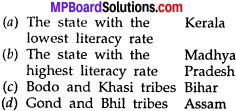MP Board Class 6th Social Science Solutions Chapter 28 The Population and Its Distribution in India
MP Board Class 6th Social Science Text Book Exercise Questions
Answer the following Questions
Question 1.
Question (a)
What are the characteristics of the Indian population? Describe one characteristic in detail.
Answer:
The characteristics of the Indian population are:
- Disparity in occupation
- Condition of the women population gender ratio
- Composition of the population as per age
- Literacy
- Variety in urban and rural population
- Culture difference
1. Disparity in Occupation:
There is disparity in occupation of the people in India. Two – thirds of the population still depends on agriculture. Only 10% of the total population is engaged in industry and other services. Thus only a little part of the population is engaged in commercial activity. It is the commercial activity which prepares useful commodities from raw material and increases their value. Thus, there is disparity in the occupation of the people.
2. Condition of the women population gender ratio:
The first and foremost component of gender statistics revealed by Census 2001, 532 million constituting 52 percent are males and 497 million constituting remaining 48 percent are females in the population. In sheer numbers, males outnumber females by 35 million in population.
3. Composition of the population as per age:
Age structure is one of the most important characteristics of population composition. Almost all population characteristics vary significantly with age. The usefulness of age data is more noticeable when it is cross classified by variables like marital status, literacy educational attainment, economic activity which vary with age in different patterns.
4. Literacy:
Literacy is one of the characteristic. Literacy means the ability to read and write.
5. Variety in urban and rural population:
The rural/urban unemployment rates show clear differences, ranging from an estimated 8.6 per cent in urban areas (1.8 million people), to 5.2 per cent in rural areas (260,000 people). The employment rate is higher and inactivity rate lower than the national average in rural areas.
6. Culture difference:
Cultural differences are the various beliefs, behaviors, languages, practices and expressions considered unique to members of a specific ethnicity, race or national origin.
![]()
Question (b)
Name the states of India which are thickly populated.
Answer:
West Bengal.
Question (c)
Describe the distribution of scheduled tribes in India.
Answer:
One – third of the Indian population belongs to the scheduled tribes. This means that a large part of the population still resides is far hilly and forest areas where the facilities of life are negligible. These people have their own culture and life styles.
The distribution of the tribal population is also uneven. The scheduled tribes in the different states of India can be divided into three major groups.
1. North – Eastern Area:
This is the most densely populated area. It consists of Arunachal Pradesh, Manipur, Assam, Meghalaya and Nagaland. The tribes that live there are Angami, Cargo, Bodo, Kuli, Naga, Mikir, Lusai, Khampa and Khasi etc.
2. Southern Area:
It consists of Kerala, Karnataka, Andhra Pradesh and Tamil Nadu. The tribes that live here are Koddar, Kannikar, Karumba, Bhuralo, Nipyam, Toda, Durula, Chechu, Purwa, Muthuwan, Bhurali, Malkuswas and Nipyon, etc. The tribes that live in Andaman and Nicobar are Jarawa, Centali, Andman and Nicobare.
3. Central Area:
It consists of southern Uttar Pradesh, Rajasthan, Bihar, Orissa, Chhatisgarh, Madhya Pradesh, Gujarat and Andhra Pradesh. The tribe that live here are Korku, Gond, Korba, Maria, Jwang, Kol, Santhal, Uraon Birhor, Bhuiya, Khariya, Bhil and Munda, etc.
![]()
Question (d)
Which scheduled tribes live in Madhya Pradesh? Name any three.
Answer:
The main scheduled tribes lived in Madhya Pradesh are Bhil, Kir, Nehal, Bhaina, Bhumiya, Gond, Korku, Baiga, and Sahariya, etc.
The districts where the scheduled tribes live are Balaghat, Mandla, Dindori, Chhindwara, Shahdol, Sindhi, Jhabua, Anuppur, Khandwa, Shivpuri, Dhar and Khargon.
![]()
Question 2.
Fill in the blanks:
(a) ……….. percentage of the Indian population lives in villages.
(b) The literacy rate of Madhya Pradesh is …………
(c) The proportion of male, female in the population is called ……….
(d) Two – thirds of the Indian population depends on ………..
Answer:
(a) 74.28
(b) 64.11%
(c) gender ratio
(d) agriculture
Question 3.
Match the following:

Answer:
